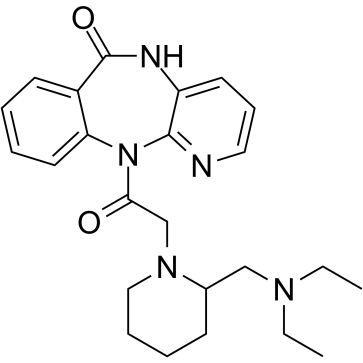Otenzepad

Otenzepad structure
|
Common Name | Otenzepad | ||
|---|---|---|---|---|
| CAS Number | 102394-31-0 | Molecular Weight | 421.53500 | |
| Density | 1.171 g/cm3 | Boiling Point | 573.2ºC at 760 mmHg | |
| Molecular Formula | C24H31N5O2 | Melting Point | N/A | |
| MSDS | Chinese USA | Flash Point | 300.5ºC | |
| Symbol |

GHS07 |
Signal Word | Warning | |
|
Acetylcholine activity in selective striatal regions supports behavioral flexibility.
Neurobiol. Learn. Mem. 91(1) , 13-22, (2009) Daily living often requires individuals to flexibly respond to new circumstances. There is considerable evidence that the striatum is part of a larger neural network that supports flexible adaptations. Cholinergic interneurons are situated to strongly influen... |
|
|
Nucleus accumbens acetylcholine and food intake: Decreased muscarinic tone reduces feeding but not food-seeking
Behav. Brain Res. 198(1) , 252-7, (2009) Separate groups of food-deprived rats were given 2 h access to food after receiving bilateral nucleus accumbens infusions of the muscarinic antagonist scopolamine methyl bromide (at 0, 1.0, and 10.0 μg/side), the M2-preferring agonist oxotremorine sesquifumar... |
|
|
Loss of muscarinic and purinergic receptors in urinary bladder of rats with hydrochloric acid-induced cystitis.
Urology 76(4) , 1017.e7-12, (2010) To clarify the basic mechanism involved in the pathophysiology of cystitis by characterizing the urodynamic parameters, pharmacologically relevant (muscarinic and purinergic) receptors, and the in vivo release of adenosine triphosphate (ATP) in the bladder of... |
|
|
Structural and functional neuroprotection in glaucoma: role of galantamine-mediated activation of muscarinic acetylcholine receptors.
Cell Death Dis. 1 , e27, (2011) Glaucoma is the leading cause of irreversible blindness worldwide. Loss of vision due to glaucoma is caused by the selective death of retinal ganglion cells (RGCs). Treatments for glaucoma, limited to drugs or surgery to lower intraocular pressure (IOP), are ... |
|
|
BK channel β1 subunits regulate airway contraction secondary to M2 muscarinic acetylcholine receptor mediated depolarization.
J. Physiol. 589(Pt 7) , 1803-17, (2011) The large conductance calcium- and voltage-activated potassium channel (BK channel) and its smooth muscle-specific β1 subunit regulate excitation–contraction coupling in many types of smooth muscle cells. However, the relative contribution of BK channels to c... |
|
|
[Acetylcholine induces human detrusor muscle cell proliferation: molecular and pharmacological characterization].
Urologia 79(2) , 102-8, (2012) The purpose of the study is to understand whether the cholinergic stimulation is important, not only in inducing contraction of the detrusor muscle, but also in modulating the proliferation of smooth muscle cells. These results could help to better understand... |
|
|
Estimation of agonist activity at G protein-coupled receptors: analysis of M2 muscarinic receptor signaling through Gi/o,Gs, and G15.
J. Pharmacol. Exp. Ther. 321 , 1193-1207, (2007) We developed novel methods for analyzing the concentration-response curve of an agonist to estimate the product of observed affinity and intrinsic efficacy, expressed relative to that of a standard agonist. This parameter, termed intrinsic relative activity (... |
|
|
Prefrontal cortex acetylcholine release, EEG slow waves, and spindles are modulated by M2 autoreceptors in C57BL/6J mouse.
J. Neurophysiol. 87(6) , 2817-22, (2002) Recent evidence suggests that muscarinic cholinergic receptors of the M2 subtype serve as autoreceptors modulating acetylcholine (ACh) release in prefrontal cortex. The potential contribution of M2 autoreceptors to excitability control of prefrontal cortex ha... |
|
|
Paradoxical effect of salbutamol in a model of acute organophosphates intoxication in guinea pigs: role of substance P release.
Am. J. Physiol. Lung Cell. Mol. Physiol. 292(4) , L915-23, (2007) Organophosphates induce bronchoobstruction in guinea pigs, and salbutamol only transiently reverses this effect, suggesting that it triggers additional obstructive mechanisms. To further explore this phenomenon, in vivo (barometric plethysmography) and in vit... |
|
|
Functional roles of muscarinic M2 and M3 receptors in mouse stomach motility: studies with muscarinic receptor knockout mice.
Eur. J. Pharmacol. 554(2-3) , 212-22, (2007) Functional roles of muscarinic acetylcholine receptors in the regulation of mouse stomach motility were examined using mice genetically lacking muscarinic M(2) receptor and/or M(3) receptor and their corresponding wild-type (WT) mice. Single application of ca... |